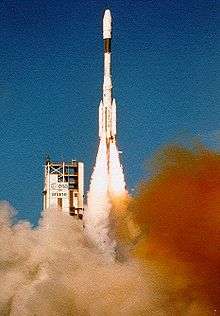Ariane (rocket family)
Ariane is a series of a European civilian expendable launch vehicles for space launch use. The name comes from the French spelling of the mythological character Ariadne. France first proposed the Ariane project and it was officially agreed upon at the end of 1973 after discussions between France, Germany and the UK. The project was Western Europe's second attempt to develop its own launcher following the unsuccessful Europa project. The Ariane project was code-named L3S (the French abbreviation for third-generation substitution launcher).
The European Space Agency (ESA) charged the EADS subsidiary Astrium, presently Airbus Defence and Space, with the development of all Ariane launchers and of the testing facilities, while Arianespace, a 32.5% CNES (French government space agency) commercial subsidiary created in 1980, handles production, operations and marketing. Arianespace launches Ariane rockets from the Guiana Space Centre at Kourou in French Guiana.
Ariane versions
| Launch vehicle | Launches: successes / total | Variants | Payload to GTO | Payload to LEO | Height | Mass | Stages |
|---|---|---|---|---|---|---|---|
| Ariane 1 | 9 / 11 | - | 1,850 kg (4,080 lb) | - | 47.46 m (155.7 ft) | 211,500 kg (466,300 lb) | 3 |
| Ariane 2 | 5 / 6 | - | 2,180 kg (4,810 lb) | - | 49.13 m (161.2 ft) | 220,950 kg (487,110 lb) | 3 |
| Ariane 3 | 10 / 11 | - | 2,700 kg (6,000 lb) | - | 49.13 m (161.2 ft) | 234,000 kg (516,000 lb) | 3 |
| Ariane 4 | 113 / 116 | 40, 42P, 42L, 44P, 44LP, 44L | 2,000–4,300 kg (4,400–9,500 lb) | 5,000–7,600 kg (11,000–16,800 lb) | 58.72 m (192.7 ft) | 240,000–470,000 kg (530,000–1,040,000 lb) | 3 |
| Ariane 5 | 93 / 98 (as of June 2018) | G, G+, GS, ECA | 6,950–10,500 kg (15,320–23,150 lb) | 16,000–21,000 kg (35,000–46,000 lb) | 46–52 m (151–171 ft) | 720,000–780,000 kg (1,590,000–1,720,000 lb) | 2 |
| Ariane 6 | In development, due for launch in 2020[1] | 62, 64 | 5,000–10,500 kg (11,000–23,100 lb) | 7,000–20,000 kg (15,000–44,000 lb) | ~63 m (207 ft) | 500,000–900,000 kg (1,100,000–2,000,000 lb) | 2 |
Ariane 1 was a three-stage launcher, derived from missile technology. Ariane 2–4 were enhancements of the basic vehicle. The major differences are improved versions of the engines, allowing stretched first- and third-stage tanks and greater payloads. The largest versions can launch two satellites, mounted in the SPELDA (Structure Porteuse Externe pour Lancements Doubles Ariane) adapter.
Such later versions are often seen with strap-on boosters. These layouts are designated by suffixes after the generation number. First is the total number of boosters, then letters designating liquid- or solid-fueled stages. For example, an Ariane 42P is an Ariane 4 with two solid-fuel boosters. An Ariane 44LP has two solid, two liquid boosters, and a 44L has four liquid-fuel boosters.
Ariane 5 is a nearly complete redesign. The two storable lower stages are replaced with a single, cryogenic core stage. This simplifies the stack, along with the use of a single core engine (Vulcain). Because the core cannot lift its own weight, two solid-fuel boosters are strapped to the sides. The boosters can be recovered for examination, but are not reused. The upper stage is storable and restartable, powered by a single Aestus engine.[2]
On 4 May 2007, an Ariane 5-ECA rocket set a new commercial payload record, lifting two satellites with a combined mass of 9.4 tonnes.[3]
By January 2006, 169 Ariane flights had boosted 290 satellites, successfully placing 271 of them on orbit (223 main passengers and 48 auxiliary passengers) for a total mass of 575,000 kg successfully delivered on orbit. Attesting to the ubiquity of Ariane launch vehicles, France's Cerise satellite, which was orbited by an Ariane in 1995,[4] struck a discarded Ariane rocket stage in 1996.[5] The incident marked the first verified case of a collision with a piece of catalogued space debris.[6]
On February 16, 2011, the 200th Ariane rocket was launched, successfully carrying the Johannes Kepler ATV into low Earth orbit.
Models
Flyable models of the Ariane 4 and 5 are available as kits from Noris Raketen in Germany and Apogee Rockets.[7] Ariane 5 scale models are offered French Heller Joustra S.A in 1/125 scale,[8] Arianespace in 1/125 and 1/100 scale,[9] and Dragon Models Limited in 1/400 scale.[10] ESA links to several paper models on its website, including Ariane 4.[11]
In 1987 Lambert Shelter built a 5.40 metre long flyable model of the Ariane, now displayed at the Hermann Oberth Space Travel Museum in Feucht. A 4.5 m, 85 kg flyable model of the Ariane 4, built by the Advanced Rocketry Group Of Switzerland (ARGOS), was launched in 2002 in Amarillo, Texas and successfully again on 19 September 2004 at 12:15 local time in the Val de Ruz in the Canton of Neuchâtel, Switzerland.
See also
References
- ↑ Amos, Jonathan (22 June 2017). "Full thrust on Europe's new Ariane 6 rocket". BBC News.
- ↑ Aestus Rocket Engine Archived 2014-02-02 at the Wayback Machine. Astrium (European Aeronautic Defence and Space Company)
- ↑ European rocket powers to record BBC news
- ↑ "SPACEWARN Bulletin Number 501". NASA. Archived from the original on 14 August 2009. Retrieved 2009-08-26.
- ↑ "Space Junk". Newsweek. Archived from the original on 8 October 2009. Retrieved 2009-08-26.
- ↑ "CO2 prolongs life of 'space junk'". BBC News. May 5, 2005. Retrieved 2009-08-26.
- ↑ "Ariane". ApogeeRockets.com. Retrieved 18 June 2015.
- ↑ "1/125 - ARIANE V". Heller. Archived from the original on 16 December 2014. Retrieved 18 June 2015.
- ↑ "MODELS". Arianespace. Retrieved 18 June 2015.
- ↑ "56230 Ariane 5G w/Launch Pad". Dragon Models Limited. Retrieved 18 June 2015.
- ↑ "Cut-out & Build". ESA. 16 May 2013. Retrieved 18 June 2015.

.jpg)